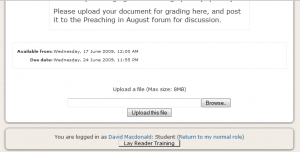In this unit on assessment tools, we were asked to create a “complete quiz or exam” in the LMS we have chosen for our project. Having finished this, I’m really not convinced that it is a tool I would use extensively in an online course for Anglican Lay Readers. Such an online course would be better served through the creation of artefacts such as written, audio- and video-recorded sermons (much the way ETEC 565 has been designed).
The assessment activity I’ve chosen to highlight here is an assignment upload activity in which students are asked to apply the knowledge they have learned from the preceding portion of their content module and the related discussion forum, compile this application of knowledge into a report and upload it for assessment.

Students are also expected to post their assignment in the following discussion forum for sharing and discussion as members of a community of practice (Lave & Wenger, 1991). This assignment will be the first of a series of assignments on preaching, each one building on the previous: first, students describe how they would go about researching and preparing for a sermon. In the next assignment, they’ll be asked to review readings for a specific Sunday and prepare a short (5 minute) written sermon. After revision based on instructor and peer feedback, students will be asked to make an audio recording of themselves presenting the sermon, followed by a video recording of the sermon being presented in church, preferably to a real congregation.
Such an ongoing series of assignments meets all of the conditions set out by Gibbs and Simpson (2004). By distributing assessed assignments, study time does not become concentrated in the period right before a test, exam or major assignment (Conditions 1, 2). These assignments prepare students for their duties through authentic activities (Condition 3). Lay Readers’ duties are carried out in a community of peers, so frequent written and conversational feedback from both the instructor and classmates is extremely relevant to the activity (Conditions 4, 5, 6, 7, 8). By situating feedback in a discussion forum, students can’t help but receive it and act on it in preparation of the following assignment (Conditions 9, 10).
Is it the assignment tool in Moodle that meets the conditions outlined by Gibbs and Simpson (2004)? No. The tool is simply that – a tool. It is the assignment/assessment design that meets these condition. To be quite frank, an LMS isn’t even truly necessary to accomplish effective assessment. A flexible blog platform or wiki could facilitate this just as easily. What the LMS does provide is a way of recording, tracking and reporting student grades. But what represents learning? A grade or the series of artefacts? In my opinion, it is the series of artefacts showing growth in understanding and ability that is evidence of learning. A grade is no more than a temporally-dependent judgement of a student’s performance level that says nothing about his or her learning.
References
Gibbs, G. & Simpson, C. (2004) Conditions Under Which Assessment Supports Students’ Learning. Learning and Teaching in Higher Education, 1, 3-31.
Lave, J. & Wenger, E. (1991) Situated Learning: Legitimate peripheral participation. Cambridge: University of Cambridge Press.